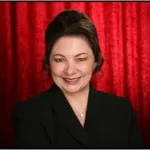
Lita’s recent discussion with editor Sharon Rose grew into a two-part author interview; the first is about the process of writing (read Part 1 here), and Part 2 on Lita’s present releases and upcoming new books is presented below.
- Q: Thank you for speaking with me about your books in more detail. You have now written and published a cookbook, two poetry books, a trilogy of international crime and mystery, a non-fiction guide book that compares sports and sex, and then a dramatic spy thriller. That makes eight books and counting, because I hear there are many more books on the way. But first, it all began with poetry. I understand you had two short poems published in a high school student collection. But was there a particular poem that spurred you on to put a collection together for publication?
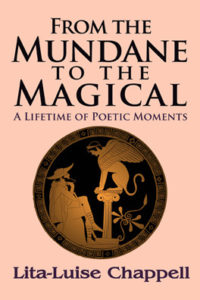 A: There was. It was a poem I wrote to my husband Vere on our third wedding anniversary, called Soul of the Sensuous. It first got published by the International Library of Poetry, in their 2004 edition, called Invoking the Muse. But it wasn’t until ten years later that the poem was included in my first poetry book, From the Mundane to the Magical. That first book had 119 poems which I had written from age fourteen through my fifties. I had to figure out a way to divide them into chapters, so I ended up doing so with poems about travel, politics, love found, love lost, magical works, special moments, and poems of length.
A: There was. It was a poem I wrote to my husband Vere on our third wedding anniversary, called Soul of the Sensuous. It first got published by the International Library of Poetry, in their 2004 edition, called Invoking the Muse. But it wasn’t until ten years later that the poem was included in my first poetry book, From the Mundane to the Magical. That first book had 119 poems which I had written from age fourteen through my fifties. I had to figure out a way to divide them into chapters, so I ended up doing so with poems about travel, politics, love found, love lost, magical works, special moments, and poems of length.
- Q: Your second book of poetry, Poetic Emanations of Light, Life, Love & Liberty, was released in 2018. Why the delay, and what made that book different?
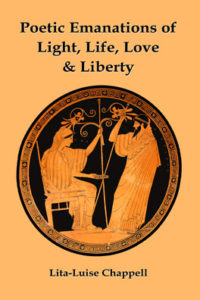 A: It just took that long to write more poems and I discovered more poems in my old files that I had written by hand before computers came into use. The second poetry book has 117 poems that were divided up into poems about light, life, love, and liberty. It contains my most recent and mature works. Even though the first book was published by Sybaritic Press out of Los Angeles, by the time the second book came along, Vere and I had established our own publication company, Templar Media. All other books after that first poetry book have been released under our label. I did maintain a similar format in the second book, as had been established in the first, with an introduction to each poetry section, block art in the interior, and a similar type of Greek art and color on the front cover.
A: It just took that long to write more poems and I discovered more poems in my old files that I had written by hand before computers came into use. The second poetry book has 117 poems that were divided up into poems about light, life, love, and liberty. It contains my most recent and mature works. Even though the first book was published by Sybaritic Press out of Los Angeles, by the time the second book came along, Vere and I had established our own publication company, Templar Media. All other books after that first poetry book have been released under our label. I did maintain a similar format in the second book, as had been established in the first, with an introduction to each poetry section, block art in the interior, and a similar type of Greek art and color on the front cover.
- Q: Your next book was The Thelemic Cookbook: Cooking with Correspondences. It’s a huge book, with 656 recipes and weighing in at 4 1/2 pounds. What made you write it, how long did it take, and how well has it been received?
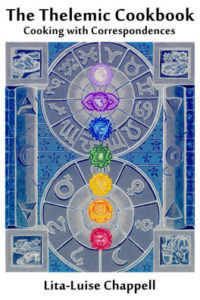 A: The cookbook was written because the Thelemic calendar has many feast days throughout the year, yet nowhere was there a list of what those feasts should consist of. It had to be magical, of course, because Thelemites are magical people. I had experience enough to write it, as I had been a chef for over thirty years, I was very familiar with magical correspondences, and I had written a cookbook before, on tofu, in the late seventies. The Thelemic Cookbook took me two years to write, because I had to determine the correspondences of over a thousand edible foods in order to assign an appropriate element, planet, astrological sign, and chakra to each food. It was not an easy task. I had to look very closely at a plant’s botany and all edible animals, with their physiology, function, and contribution to the human body. That book has done well. It is about to go into its fourth printing.
A: The cookbook was written because the Thelemic calendar has many feast days throughout the year, yet nowhere was there a list of what those feasts should consist of. It had to be magical, of course, because Thelemites are magical people. I had experience enough to write it, as I had been a chef for over thirty years, I was very familiar with magical correspondences, and I had written a cookbook before, on tofu, in the late seventies. The Thelemic Cookbook took me two years to write, because I had to determine the correspondences of over a thousand edible foods in order to assign an appropriate element, planet, astrological sign, and chakra to each food. It was not an easy task. I had to look very closely at a plant’s botany and all edible animals, with their physiology, function, and contribution to the human body. That book has done well. It is about to go into its fourth printing.
- Q: Congratulations. After the cookbook, you created the Reynard Trilogy, after the surname of your three main characters, Chante, Lucien, and Gervais Reynard. There was The Collioure Concealment, Murder of the Mystras Nun, and The Cypriot Secret. How did you get the idea to write those books?
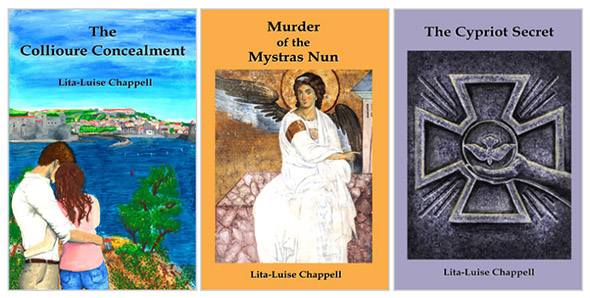
A: Vere and I were on vacation in Greece, and decided to visit the ancient town of Mystras, located on Mount Taygetos, near Sparta in the Peloponnese. Vere decided to hike up the mountain to the town’s castle, but I chose to wander the lower levels. The place was mystical but cold on that winter day, with no other visitors around. Snow lightly fell in a twilight-like light, while centuries of history just rolled down that mountain and into my imagination. That’s when I got the idea for the second book. I went back to the car and started writing. By the time Vere got back, I’d written about twenty pages. When we returned home, I filled in the storyline and then realized that I had such a long story to tell that it might not all fit in one book. I decided that the story I had come up with needed to have a formal beginning, in order to introduce the characters, their relationship, and the type of work they would eventually do together. When we went back to France, I got an idea of how to do that and created the first book, The Collioure Concealment. Then I went back to complete the second book, and on to the third to finish the series.
- Q: I understand you wrote the trilogy because you wanted to have your audience grasp an important underlying message. What is that message? Is it the same in each book or different?
A: My mission is to fight against superstition, tyranny, and oppression, and these books were written to do just that. The message in The Collioure Concealment is that no matter what, we must always keep asking questions to get at the truth, especially when there does not seem to be a good answer, or whenever an answer seems too patently easy. Truth is seldom found at the surface.
The message in Murder of the Mystras Nun, is that we must learn to examine all angles of a problem. One view is never enough to grasp the entire truth of a matter. Just because something has an established history and seems above reproach, doesn’t mean that a different story is not hiding somewhere below. One should always look further and deeper. Also, that a given ethics may not be as sound or as honest as proclaimed. Superstitions are invasive lies and a means of control. And all too often, religion is used not as a balm of comfort, but as a repressive subjugation to authority. As well, tyranny has a sly way of escalating. It comes in many forms and is all too often, first accepted when it should not be. As one of my poems on fighting for freedom reminds us, “freedom was never easily won with just one breath.”
The message in The Cypriot Secret, is that although we may only have one small clue to follow when searching for the truth, we owe it to ourselves to exhaust all possibilities to confirm it, even if we only have a gut feeling and an enigmatic intuition. Like a detective, we must take all into account. All too often, it is the smallest inconsistent details, the seemingly irrelevant things that may prove to be just as important. And finally, by doing so, we learn how to see the interconnectedness of those things, which may bring us to a more correct conclusion. So the overall message of the trilogy is that the truth is never easy to discover, and just because you were told something, doesn’t make it true. - Q: Thank you, there are several good lessons there. The trilogy begins and ends with secrets about the Knights Templar, and you named your publication company, Templar Media. History about the Templars seems to have seeped into so much of our popular culture through books and films. What do you think it is that draws so many people to the story of the Templars?
A: You mean, besides the point that there is widespread belief in a Templar treasure of insurmountable wealth still out there, waiting to be found? Their popularity is based on much more than a treasure. Their story is a lesson for us all, for all time. What happened to the Templars is an ongoing dire warning about what subjugation by the church and state can do. Of the 167 countries measured for democracy, the 2019 democratic index shows that 54 countries are under complete authoritarian rule, 36 are under some kind of hybrid regime, 55 of them have a flawed democracy, of which the U.S. is one, but only 22 countries enjoy full democracy. That means that the peoples of most nations can easily identify with a lack of freedom, and may actually feel tormented and persecuted for who they are and what they believe. The Templars were first organized and run by the church, but the church in tandem with the state, turned against them. There is nothing heroic about being a martyr, they are only victims. Fighting for truth and freedom has always been an uphill battle. And that is why the story of the Templars has meaning for so many.
- Q: That is hard to hear, but understandable. After the trilogy you put together the second poetry book, which we have already discussed. But after that, you switched genres and wrote a non-fiction, social commentary guide to sex and sports, called Sticks and Balls: A Sexologist Pokes Fun at Sports. How did that come to be and what is the book about?
 A: I got the idea for Sticks and Balls after I retired as a sex therapist. There had been two clients who turned my attention to sports. One had a sexual challenge as a professional baseball player, and the second had a sexual challenge with a husband who was a big fan of football. I researched both sports and what I noticed was surprising. I discovered that most of the hormones that get stimulated and produced in the body when sexuality is involved, are the same hormones that get produced when an athlete plays sports—and even get stimulated in a person just by viewing that sport as a spectator. And, I knew there were many sports words that had a sexual connotation, but I never realized there were so many. That’s when I knew that I had the makings of a book. But there are hundreds of sports. I had to limit it, so I chose to stay with thirty-five sports that are played with either a stick, a ball, or both. Each sport has its own chapter, with a thumbnail review of that sport’s history, details of the stick or ball used, and the words in that sport that have a sexual connotation. It’s a pretty fascinating study.
A: I got the idea for Sticks and Balls after I retired as a sex therapist. There had been two clients who turned my attention to sports. One had a sexual challenge as a professional baseball player, and the second had a sexual challenge with a husband who was a big fan of football. I researched both sports and what I noticed was surprising. I discovered that most of the hormones that get stimulated and produced in the body when sexuality is involved, are the same hormones that get produced when an athlete plays sports—and even get stimulated in a person just by viewing that sport as a spectator. And, I knew there were many sports words that had a sexual connotation, but I never realized there were so many. That’s when I knew that I had the makings of a book. But there are hundreds of sports. I had to limit it, so I chose to stay with thirty-five sports that are played with either a stick, a ball, or both. Each sport has its own chapter, with a thumbnail review of that sport’s history, details of the stick or ball used, and the words in that sport that have a sexual connotation. It’s a pretty fascinating study.
- Q: Okay, you have me curious. Which sport has the most sexual terms in their list of sports terms? I suspect it’s baseball. Am I right?
A: I’m sorry, you guessed incorrectly. Baseball may have 1,164 terms, the most of all other stick and ball sports, but only 146 of those terms have a sexual connotation, which is only 12.54% of its total terms. Surprisingly, the sport that has the greatest percentage of sexual words at 68%, is the game of hurling. Readers will have to read the book to understand why. I was never much of a sports fan, but after analyzing so many sports, the hormones that get produced, and their terminology, I came to realize why sports are the most popular form of entertainment, after sex. - Q: After that book, you went back to writing another international crime and mystery book, in the form of a spy thriller, Hiding in Paradise. It’s a fun and fast moving book. What made you want to write about spies and agents, and have Croatia as the country to begin the story? And I assume there is also an underlying message in that book. If so, what is it?
A: In 2013 Vere and I traveled to Croatia and I was so impressed with its beauty, I thought it would make a great setting for a book. It was a fun way of highlighting the country where I have some wonderful friends. I also wanted to try my hand writing about government intrigue as a thriller. The main character, Samena Branko, must run for her life with a political secret. She is pursued by disreputable forces attempting to get that secret information back, as well as international police who are trying to find her before she is killed for having that information. It’s a race across, not only Croatia, but also Spain, Italy, and the U.S. The book ends in another one of my favorite places, Yelapa, Mexico, where I have been to several times. And that’s where the paradise part of the title came from. The message in this book is that paradise is a state of mind, not a place.
- Q: I understand you have already finished your next book. What is it called, what is it about, and is there also an underlying message in that book?
A: It’s called The Blythewood Curse, which I hope to have released in July. It’s an occult novel about Druids and witches in northern England in 1890. It is a mystery, as well as being a magical romance. A young boy, Rowland, moves with his mother to the North York Moors. He is enrolled in the local primary and meets his teacher Beth and her daughter Tess, who befriend the boy. Tess seems to have a magical way with animals, and Rowland wants that same power. Beth decides to secretly teach him, but she has an ulterior motive in mind. Behind the proper and respectable school teacher front is a mysterious woman of Celtic Druid tradition. But there is a curse upon Beth and Tess, and they believe that Rowland might be their way toward becoming free from it. Only the curse is not what they think, and it ends up involving the entire town. The message within the book is about flawed belief systems, and how power can be misunderstood and misused for personal gain. It is also about religious persecution and the harm it can cause.
- Q: I look forward to that. I understand you are also trying your hand at producing a book for children. What is that about, and when can we expect to see it released?
A: In my first poetry book, the last poem was a long poem for children. I decided it would make an entertaining book for young adults, as well as being an instructive book for building good character. It’s called, The Town with the Feather Crest. It teaches empathy for the greater good, ingenuity in the face of danger, and courage to follow out a plan. A young man in his travels comes to a beautiful castle. But all is not what it seems. At the castle gate he meets the guard who tells him about the spell that is over the town. The guard senses that the lad has a good heart, and convinces him that he is the one to defeat the dragon who is stealing townspeople away. So the lad sets off knowing where to go, but is not entirely sure how to accomplish the task. It involves the feather of truth, which can change everything, but it is the lad’s ingenious delivery system that wins the day. I found a very talented illustrator, Los Angeles artist Francisco Enciso, who is creating all of the images. I’m looking at releasing this book in November on the Amazon Kindle Kids Edition for easy downloads.
- Q: That would make book number ten. Is there anything else in the works? You seem to favor linking history to the present.
A: Yes, I am nearing completion on another occult fiction, The Sylvan Woods of Lake Nemi. In 2019, Vere and I traveled to Rome, and on one side trip we went to the Alban Hills, to the south. The picturesque village of Nemi is perched on the edge of an extinct volcano, and below is Lake Nemi. On its northeastern lake shore are the ruins of the ancient Temple of Diana. In the story, Elena Morandi is a sociology student who must fulfill a requirement of field work in order to complete her degree. She arranges to work over the summer with a local professor of history, and helps the local archaeologist on his dig at the temple site. Elena somehow finds her way into a tunnel under the cliffs, walks right into another time, and gets an education she never anticipated. There is also the mystery of who is smuggling ancient Roman artifacts from the site, and there is a murder, which brings in local authorities. How she reckons with the past and the present are her challenges.
- Q: That sounds really good. Any other books planned, after that?
A: I already have a detailed storyline for a paranormal horror and romance, called The Heart of Romani Pearl. A Romani family travels through Romania selling their wares and sharing their knowledge. The leader’s daughter falls in love with a young man in a nearby forest. But he has lured her in for a most nefarious purpose. When she discovers the truth of his plan, she must figure out a way to leave clues for her family, who are searching for her. But the forest is known to be haunted, and a powerful Lord rules it. A deal must be struck with him, in order to get their daughter back, but it has its price. It is a romantic plight for her, and a moral plight for her family, all with no guarantees.
- Q: That sounds really good, too. Any other non-fiction books coming up in the future?
A: Yes. I have already begun with collecting historical data for a book called, The Dismantling of Religion. I take a look at religions of the past and examine why they failed. Then I look at present religions and how they are burdened by the seeds of the same problems, indicative of their eventual failure, as well. It ends with a glimpse into the future, with how and why all religions will eventually become a thing of the past. It just takes generations of belief to shift to non-belief, thus ending the need.
- Q: You are writing in quite a few genres of fiction and non-fiction. What seems to be your favorite?
A: I don’t know yet. I like them all. I just write as ideas come to me. I am also putting together a book of short stories, one of fairy tales, a book of travel stories, an art book of food design, and a new mystery series, called The Puzzler.
- Wow Lita, it sounds as though your keyboard hands are and will continue to be very busy. I’m sure your readers will join me in wishing you the best, and we look forward to reading all your works as they become available. Thank you!
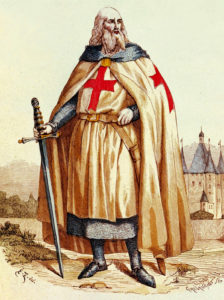
About the interviewer: Sharon Rose is a reseller of collectibles, rare books and vintage ephemera, as well as an independent copywriter and editor from Los Angeles. She has been working with books, words and found treasures for over 23 years.
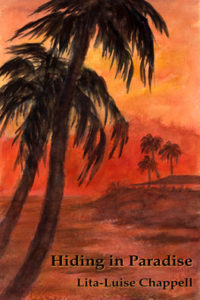
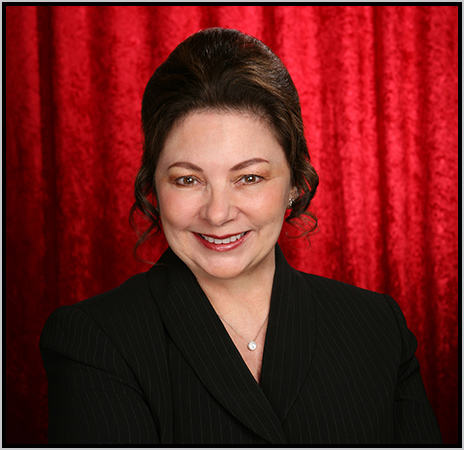 The official website of Lita-Luise Chappell, writer on sex, magic, food, distant lands, and everyday life with articles, poetry, novels, travelogues, rituals, cookbooks, and short-stories.
The official website of Lita-Luise Chappell, writer on sex, magic, food, distant lands, and everyday life with articles, poetry, novels, travelogues, rituals, cookbooks, and short-stories.